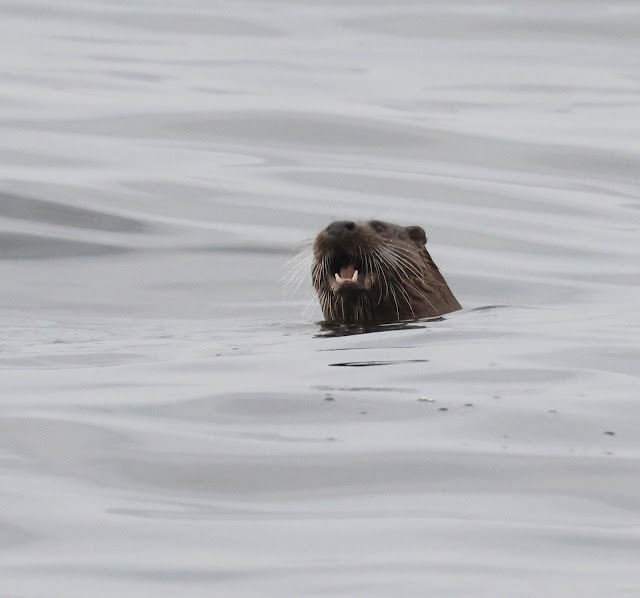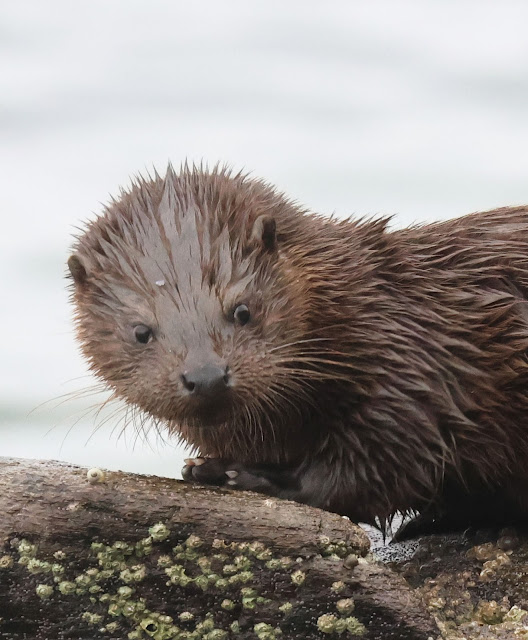After two weeks of sunshine the weather today, in this part of west Scotland, has reverted to a more typical greyness with a smirrr of rain that made venturing outside on foot with camera and bins questionable.
Undaunted I reverted to the car, using it as a mobile hide to check the seashore from the road that runs along the northwestern side of Arran where we are based. If you rise at six am there is little human activity evident in this part of the island until around eight thirty which gives a window of opportunity to drive slowly along the road, which is hardly ever more than twenty or so metres from the seashore.I am able to stop at will wherever and whenever I like without the fear of any vehicle coming up behind me.It is the ideal solution for this kind of weather and for covering a more extensive part of the shoreline than would be possible on foot.
Specifically this early morning I was looking for Otters which, like me, prefer this time due to the absence of people and thus gives me a better chance to encounter them. It does not always work but sometimes it does.
Today I set off driving out of Catacol, the tiny collection of houses where we are staying, passing by prolific banks of head high gorse that even in dull weather glow unfeasibly golden.
On one side of the road was the sea, the tide full and on the other rose small mountains, their tops invisible under a shroud of low cloud that occasionally dispensed a gentle rain.
I stopped at the bridge where the road passes over the Catacol Burn, its crystal clear waters tumbling noisily over and through the boulders and stones that mark its rocky course to the waiting sea. It is here, close to the burn's mouth, that Red breasted Mergansers like to tarry and, sure enough two, a male and female, were here this morning but I knew that to photograph them would need all my skill in stalking them. I parked the car off the road and slipped behind a huge stand of gorse. Judicious use of the gorse allowed me to approach fairly close and remain unseen.The birds are always very wary and would swim out to sea or fly away at the slightest intimation of my presence.
I had low expectations of success but managed to conceal myself behind the head high gorse almost as far as the riverbank and by standing on a large, moss covered stone look through a gap in the gorse flowers that gave me an uninterrupted view of the birds, still ever wary but remaining where they were. I stood silent and unmoving and eventually they relaxed and commenced to preen, each standing on a submerged rock in the shallow water.
I watched the mergansers for ten minutes and then retreated to the car, ensuring that they did not notice me leaving and thus remained undisturbed.
I drove on, checking the seashore and came to a stop at a place called Thunderguy which is no more than a group of five houses. I had noticed two Black Guillemots sat on a rock exceptionally close to the road.They breed here under huge boulders above the tideline and are usually confiding. This pair were no exception.Around here it is not an uncommon sight to see pairs of these birds sat or standing on a rock on the seashore. I have seen up to twelve together, the males uttering their high pitched seeeeee call as they courted females, a sound totally at odds with the usual grating calls of other auk species.
Ultimately they decided they were too close to the road and me too close to them to feel secure, so they flew back to the sea
I left them, drove on and after another few miles turned the car around and commenced to drive back to our cottage, all the while checking the rocks which were now beginning to be exposed by the slowly falling tide. My intention was to check the rocks for any unusual outline as this can sometimes reveal an Otter.
Yesterday this was precisely what happened, when having driven past a particular rock on my drive out there was nothing to cause interest but on returning the same rock had acquired an extra dark shape on its top. It was an Otter asleep.I got out of the car and managed a couple of images before it became aware of me and unhurriedly slipped into the water and was gone.
I am slowly learning the ways of the Otters on Arran but for me they still remain unpredictable and tantalisingly elusive. Sometimes they opt to sleep in the open on rocks or seaweed but on other occasions swim in from the sea and disappear into the rocks. I have seen many Otters swimming and although the sighting of any Otter is something remarkable and exciting I much prefer to find them out of the water as you then see the whole animal and not just a head and tail. It is far more rewarding in my opinion.
Otters when awake spend most of their time hunting fish and crustaceans in the sea and often consume them there but if the victim is too large to cope with at sea or might escape the Otter will swim determinedly to the shore to deal with its prey.This has given me the best opportunities to see them out of the water and has resulted in some memorable encounters such as one that caught a large dogfish at Catacol and spent twenty minutes subduing and eating it and another by Brodick seafront that captured a lobster, both having to deal with their victim out of the water.
Now returning to today and, half way back to the cottage, I saw another strange shape on the top of a rock.Many of the rocks here have unusual contours so it does not always mean it is an Otter but it is always wise to check.
This however was the real thing. Unmistakeable in profile. An Otter!
I rapidly stopped the car, reversing back onto the verge to get level with the animal but remained in the car.The Otter was a young one and whistling quite audibly so obviously there was a mother nearby. The young Otter was finishing a meal of fish. I lowered the car window and took a few images of the Otter on the rock before it dropped down the side of the rock and into the sea.
It swam a little way out and joined another, presumably its mother and then there were three so I was now watching a mother and two cubs. Absolutely fantastic.They swam parallel with the shore and not very far out. I turned the car as they were swimming back and away from me.I planned to get well ahead of them which would allow me to leave the car without causing alarm. This achieved I dropped down some fifteen feet onto the shore where my profile would be concealed by a bank of rocks and vegetation behind me,
While scrambling down the bank I was careful ,in my haste, not to slip and do expensive damage to the camera or worse,myself. Believe me it has been a close call on a number of similar occasions to this!
Standing by some rocks almost at the sea's edge I could see the swimming Otters in the distance but no more than twenty or so metres offshore. Swimming Otters are distinctive with square head and nostrils tilted upwards, their back awash in the water with hindquarters and tail trailing on the surface.Once encountered it is a very recognisable profile, especially on such a morning as this when the sea was relatively calm and smooth.
With anxiety levels rising I waited as they progressed, diving and hunting fish as they approached, coming ever closer. It could go either way in the next few minutes.They might see or sense me and disappear or they could carry on coming towards me. To my immense relief their course never deviated but I could only see two, mother and a cub. Then they were opposite me and in no obvious hurry, messing around and swimming back towards some rocks to my right.
Once more I heard the whistle of an Otter but it was not emanating from the two in the sea, it was coming from the rocks to my right but due to their uneveness I couldn't see the Otter making the whistling as it was in a fold of the rocks. I dared not move for if I did it would alert the Otters in the sea, now very close to me and also probably scare the Otter currently just metres away in the rocks.
I stood on the stony beach and hoped.There was nothing else I could do. I was willing the whistling Otter to make itself visible but so far nothing had happened apart from the whistling coming at regular intervals but then even the whistling ceased and I resigned myself to the fact there was to be no close encounter with an Otter.
For a minute or two I stood looking at the other two Otters in the sea. Not a sound apart from waves gently breaking on the shore. Then I was delighted to hear the whistling recommence and even closer to me but where was the Otter? Why could I not see it? Then came the slightest movement in the rocks and the young Otter revealed itself as it clambered up onto a rock above the sea
Literally metres away, hardly daring to breathe or move I pointed the camera and hoped. Surely it would see me? There was no time to check the camera settings as this encounter might be over in seconds.
The young Otter continued its high pitched whistling and wandered around the rock.Its mother came to check if all was well and was obviously concerned that it was not following her and its sibling into the water.
For five maybe six minutes the young Otter was before me and then it left the rock with its mother and the three Otters swam a hundred metres further before coming to land and disappearing into an inaccessible pile of rocks and not re-appearing.
I assume this was where their holt was but it was impossible to get to and anyway I did not want to encroach on them further but rather, I was content to leave them in peace. I could hardly better what I had just experienced.
The weather was becoming ever more bleak, the greyness and declining visibility oppressive but there was light in my heart. Yet again Arran had produced an Otter encounter that will live long in my memory,


.jpg)
.jpg)















.jpg)













.jpg)
Fantastic!!!
ReplyDelete🤗🏴
DeleteI have just avidly absorbed two of your blogs based around Catacol. We are very much looking forward to staying at Pirnmill next May. Both pieces have peaked my enthusiasm even more than it was before. The encounter with the Otters being the highlight. Great images. I hope to emulate some of them when I'm there.
ReplyDeleteThank you Rob.We wil be staying at Catacol from 19th May.Hopefully we will meet on the shore some morning! Best wishes
Delete